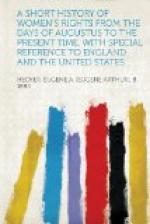[Sidenote: Divorce. Authorities as above; and Howard, ii, 3-117.]
Until the Reformation divorce was regulated by the canon law in accordance with the principles which I have explained. After the Reformation the matter at once assumed a different aspect because all Protestants agreed in denying that marriage is a sacrament. Scotland in this as in other respects has been more liberal than England; as early as 1573 desertion as well as adultery had become grounds for divorce. But in England the force of the canon law continued. In Blackstone’s day there were still, as under the canon law, only two kinds of separation. Complete dissolution of the marriage tie (a vinculo matrimonii) took place only on a declaration of the Ecclesiastical Court that on account of some canonical impediment, like consanguinity, the marriage was null and void from the beginning. Separation “from bed and board” (a mensa et thoro) simply gave the parties permission no longer to live together and was allowed for adultery or some other grave offences, like intolerable cruelty or a chronic disease. However, some time before Blackstone’s day it had become the habit to get a dissolution of marriage a vinculo matrimonii for adultery by Act of Parliament; but the legal process was so tedious, minute, and expensive that only the very rich could afford the luxury.[401] In the case of a separation a mensa et thoro alimony was allowed the wife for her support out of her husband’s estate at the discretion of the ecclesiastical judges.
The initiative in divorce by Act of Parliament was usually taken by the husband; not until 1801 did a woman have the temerity so to assert her rights. The fact is, ever since the dawn of history society has, with its usual double standard of morality for men and women, insisted that while the husband must never tolerate infidelity on the part of the wife, the wife should bear with meekness the adulteries of her husband. Plutarch in his Conjugal Precepts so advises a wife; and this pious frame of mind has continued down the centuries to the present day.




